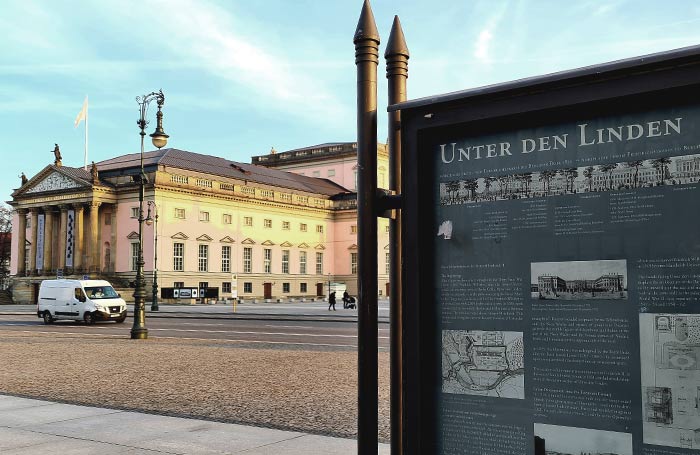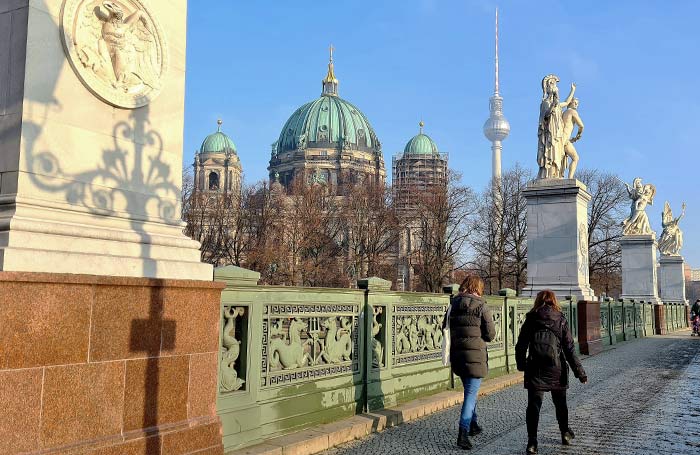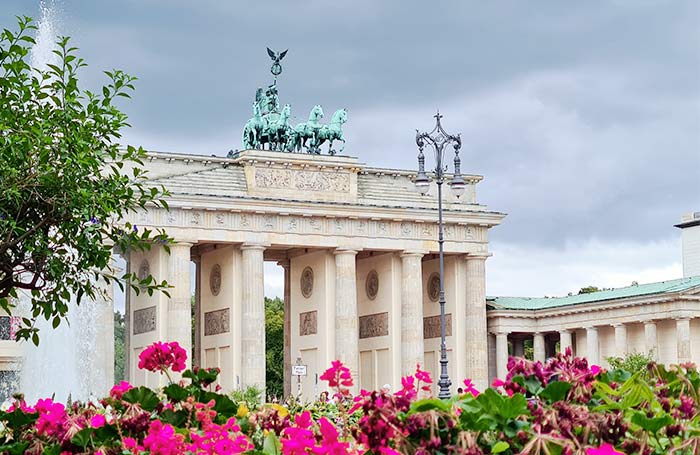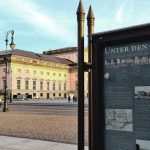Under den Linden, Berlin's most famous boulevard.
“As long as on Unter den Linden the old trees bloom, nothing can surpass it, Berlin is still Berlin!”
So says a song written in 1949. By singing it, Berliners wanted to regain enthusiasm and hope after World War II and feel that the former beauty and visitors would return.
And so it was. Today, millions of people from all over the world walk this mile of history in search of its traces. Once again, as Marlene Dietrich sang, tourists “from different countries, you see them walking, from Paris, Rome or Madrid and even some from Berlin.”
Times have changed, however, and Unter den Linden – translatable as “under the lime trees” – is no longer the majestic boulevard it once was, but something still remains of its glory. The myth endures, even if no one now dedicates songs to it.
I myself, who have lived in Berlin for 10 years, often walk along the boulevard “under the lime trees” as a Berlin tour guide. As a Berliner, hardly ever… but a tour of Berlin must include these 1500 meters of history, because without them much of the city becomes elusive.

UNTER DEN LINDEN IN THE POST-WAR PERIOD. THE RUINS UNDER THE LIME TREES
“We enter directly into Unter den Linden, the great avenue under the lime trees, once considered one of the most beautiful in the world. Now all that remains are blackened columns, gateways into the void, foundations overrun by moss and grass. Not a single square meter has been rebuilt.”
This is how Gabriel García Márquez described his arrival into East Berlin a few years before the construction of the Berlin Wall. The destroyed metropolis was “an absurdity” for the young Colombian journalist.
If he were to walk through the city again today, Unter den Linden would probably surprise him: not because the beauty that was attributed to it at the beginning of the 20th century has returned, but because there are no longer any traces of the destruction of the war. The lime trees have grown back, and in spring, the scent of their flowers gives the boulevard a special touch.
Unter den Linden is no longer a showcase for the tragedy of war, but the most popular promenade for tourists in Berlin. “Under the lime trees”, one returns to what it was before Berlin was bombed.
AN EMBLEMATIC PLACE: UNTER DEN LINDEN
Every big city has its emblematic avenues and streets, these places that those who visit a city for the first time consider essential stops. Unter den Linden is one of those places and that is why it is part of the ESSENTIAL BERLIN TOUR.
“Under the lime trees” is not easy to love, because the 20th century has left it a bit desolate. The only angelic figure that remains is mounted on a chariot and seems to be ready to ride down the avenue. It is the Goddess of Victory, who decorates the Brandenburg Gate.
At the other end of the avenue stands Frederick the Great, riding his horse towards the Royal Palace which has been rebuilt after 50 years of absence.
Unter den Linden begins at the River Spree, as you leave Museum Island behind, and ends a kilometer and a half later at the Brandenburg Gate.
Between the Palace Bridge, decorated with Greek-inspired sculptures, and the monument dedicated to Frederick II, Unter den Linden is the only place to retain the memory of linden trees in its name. Originally, this space, which today is one of the most beautiful on the boulevard, was not part of Unter den Linden; it was the Nazis who extended it to the Spree to make it more grandiose.
Until World War II, Under the Linden was 1.5 kilometers of magnificence. Today, things have changed. Tons of bombs in the 1940s, communist urban planning and a reconstruction after reunification that thought more about investors and less about aesthetics have changed its face.
Today Unter den Linden has some nice details, but it is certainly no longer one of the most beautiful boulevards in the world.

UNDER THE LIME TREES: AT THE BEGINNING IT’S ALL ABOUT SIZE
Walking it in the direction of the Brandenburg Gate, the beginning is very promising. After leaving the Lustgarten on Museum Island behind and crossing the beautiful palace bridge (Schlossbrücke), we come across the reconstruction of a series of buildings. If we move from east (Alexanderplatz) to west (Victory Column) and look first to the right and then to the left we will see:
Zeughaus: this building houses the museum of German history. Originally conceived in the late 17th century as an arsenal and then transformed into a place to celebrate Prussian military glory.
Kommandatur: a recent reconstruction (2003) that once housed Berlin’s military command.
The New Guard: a building designed by Berlin’s most important 19th-century architect, Schinkel. Today it is a memorial to the victims of world wars and totalitarianism.
Kronprinzenpalais: The crown prince’s palace was built in the 18th century, used as a museum of modern art after the fall of the monarchy, and destroyed by the war. This pale pink building was rebuilt during the communist era as a guest house for the town hall. The Treaty of Unification between the German Democratic Republic and the Federal Republic of Germany was signed here.
Humboldt University: This building, originally designed to house a palace, was donated by the royal family in the early 19th century for the creation of a university. Today it is the central building of one of the three major public universities in Germany’s capital.
The State Opera: the home of Berlin’s oldest symphony orchestra (Staatskapelle) is today one of Berlin’s three opera houses. This building, unlike the previous ones, has an interior inspired by the original historical model.
The Prussian State Library: The former building of this Berlin institution now houses the law faculty of the Humboldt University. It is located on Bebelplatz across from the Staatsoper and Berliners know it as the “Commode”, the dresser.
The new building (which in the meantime is the old one, since the library has a second modern branch in West Berlin) is next to the university and occupies an entire block. It is one of the most important libraries in the world. The building on Unter den Linden was built more than 100 years ago.

BETWEEN FRIEDRICHSTRASSE AND BRANDENBURG GATE
When you reach the intersection with Friedrichstrasse, in the 1920s the most chaotic intersection in Berlin, the character of the avenue changes. The monumental style remains behind and is replaced by a combination of socialist architecture, recent buildings of discreet beauty and a few historical facades.
In the first block on the left, we find buildings from the socialist era. Opposite, some historic facades give a glimpse of what was lost under the bombs. The socialist buildings include a hotel – at the time the only 5-star hotel in East Berlin – and the administrative offices of the Berlin Comedy Opera.
Even if the architecture here does not seduce us, it is in these meters that there are more opportunities to spend time. A few stores and restaurants between Friedrichstraße and Wilhelmstrasse invite you to sit and watch others stroll by.
What the citizens of the German Democratic Republic called “the world’s most representative cul-de-sac” still runs past the embassy of the Russian Federation, which is a magnificent example of Stalinist architecture. Since the time of the GDR, the embassies of a number of “socialist sister countries” have stood in front of it, most notably Poland.
In the socialist era, it was advisable, according to the most prominent officials, that in these last meters before the Brandenburg Gate, on the prestigious Paris Square, “friendly” institutions would be hosted.
The Gate, at the time, was part of the border with West Berlin and was in the middle of the death strip of the Berlin Wall: thus the end not only of an avenue, but also of a Country and a political system.
The Brandenburg Gate is the monument that closes Berlin’s most famous promenade, or perhaps for many, it begins it!
A PLACE TO VISIT: UNTER DEN LINDEN IN BERLIN
Napoleon, Hitler and Stalin have walked Unter den Linden, and the Berliners have greeted them with more or less enthusiasm… but far more important than these gentlemen and their mania of grandeur, have always been the Berliners and visitors to the city: they are the ones who have made history.


